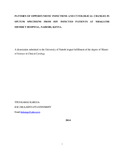| dc.description.abstract | Background information: Patients with advanced stages of HIV infection are vulnerable to
secondary infections that are generally termed as opportunistic infections (OIs). This is because
the microorganisms take advantage of the opportunity offered by a weakened immune system.
Respiratory opportunistic infections commonly associated with HIV includes pneumococcal
pneumonia, Pneumocystis jiroveci pneumonia and tuberculosis. Sputum is one of the specimens
that can be utilized in making a rapid diagnosis of opportunistic infections.
Objective: To describe the pattern of opportunistic infections and cytological changes in
sputum specimens from HIV infected patients from Mbagathi District Hospital (MBH), TB
Clinic, Nairobi, Kenya.
Study design: A cross-sectional descriptive study.
Setting: This study was conducted at MDH TB Clinic, Nairobi, Kenya, between February and June
2013.
Study population: Adults 18 years and above attending MDH TB Clinic, who submitted sputum
specimens for diagnosis of OIs diagnosis.
Main Outcome Measures Age, gender, clinical information (coughing, chest pain, difficulty in
breathing and loss of weight), correlation (CD4+ Lymphocytes), laboratory results (presence or
absence of opportunistic infections and epithelial cellular changes)
Material and methods: Demographic and clinical information was collected by direct interview
of the patients. Two sputum samples per patient were obtained, pick and smear technique was
used to prepare smears which were stained using Papanicolaou and Heamatoxylin and Eosin
stain. The remainder of the sample was processed using bleach centrifugation method and
stained with Ziehl Neelsen stain.
Result: A total of 100 HIV infected patients were studied. Majority of the patients, (51%) were
female, while remainder were male (49%). The mean age was 38.98 years (± 10), with a
median (IQR) 193.5 cell/mm3 (134.3, 269.5). Inflammatory changes were seen in 57% of
patients, atypical squamous cells of undetermined significance (ASCUS) in 4%, negative findings
in 34%. and unsatisfactory smears were 5%. The commonest opportunistic pathogen was
Mycobacterium species (30%) and Candida species (14%).
Conclusion: Majority of these HIV infected patients had inflammatory changes in the
sputum, with Mycobacterium, Candida and Aspergillus species the pathogens that were detected.
Recommendations: Sputum cytology should be used for preliminary diagnoses of opportunistic
pathogens before confirmatory test | en_US |
| dc.description.department | a
Department of Psychiatry, University of Nairobi, ; bDepartment of Mental Health, School of Medicine,
Moi University, Eldoret, Kenya | |

